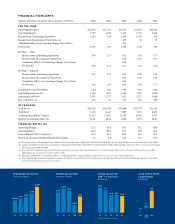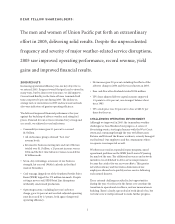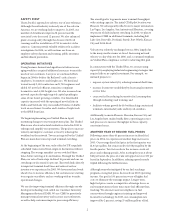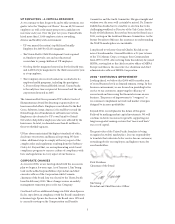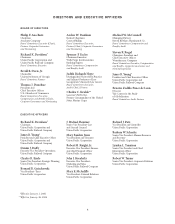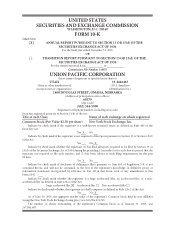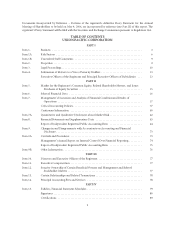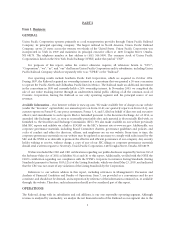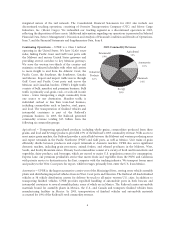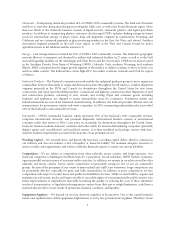Union Pacific 2005 Annual Report Download - page 12
Download and view the complete annual report
Please find page 12 of the 2005 Union Pacific annual report below. You can navigate through the pages in the report by either clicking on the pages listed below, or by using the keyword search tool below to find specific information within the annual report.
of these domestic suppliers discontinues manufacturing locomotives, we could experience a significant cost
increase and risk reduced availability of the locomotives that are necessary to our operations.
Employees – Approximately 87% of our 49,747 full-time-equivalent employees are represented by 14 major rail
unions. Under the collective bargaining round that began on November 1, 1999, all unions reached new labor
agreements with the railroads in 2005. In January 2005, we began the next round of negotiations with the unions.
Existing agreements remain in effect and will continue to remain in effect until new agreements are reached or the
Railway Labor Act’s procedures (which include mediation, cooling-off periods, and the possibility of Presidential
intervention) are exhausted. Contract negotiations with the various unions generally take place over an extended
period of time, and we rarely experience work stoppages during negotiations. The current agreements provide for
periodic cost of living wage increases until new agreements are reached.
Discontinued Operations – In November 2003, we completed the sale of our entire trucking interest, and, as a
result, included the operations of OTC and Motor Cargo in discontinued operations (see note 13 to the Financial
Statements and Supplementary Data, Item 8).
GOVERNMENTAL AND ENVIRONMENTAL REGULATION
Governmental Regulation – Our operations are subject to a variety of federal, state, and local regulations,
generally applicable to all businesses (see also the discussion of certain regulatory proceedings in Legal
Proceedings, Item 3).
The operations of the Railroad are subject to the regulatory jurisdiction of the Surface Transportation Board
(STB) of the United States Department of Transportation (DOT) and other federal and state agencies. The
operations of the Railroad are also subject to the regulations of the Federal Railroad Administration (FRA) of the
DOT. The STB has jurisdiction over rates charged on certain regulated rail traffic; freight car compensation;
transfer, extension, or abandonment of rail lines; and acquisition of control of rail common carriers.
DOT and the Occupational Safety and Health Administration, along with other federal agencies, have
jurisdiction over certain aspects of safety, movement of hazardous materials, movement and disposal of
hazardous waste, emissions requirements, and equipment standards. Various state and local agencies have
jurisdiction over disposal of hazardous waste and seek to regulate movement of hazardous materials in areas not
otherwise preempted by federal law.
Environmental Regulation – We are subject to extensive federal and state environmental statutes and regulations
pertaining to public health and the environment. The statutes and regulations are administered and monitored by
the Environmental Protection Agency (EPA) and by various state environmental agencies. The primary laws
affecting our operations are the Resource Conservation and Recovery Act, regulating the management and
disposal of solid and hazardous wastes; the Comprehensive Environmental Response, Compensation, and
Liability Act, regulating the cleanup of contaminated properties; the Clean Air Act, regulating air emissions; and
the Clean Water Act, regulating waste water discharges.
Information concerning environmental claims and contingencies and estimated remediation costs is set forth
in Management’s Discussion and Analysis of Financial Condition and Results of Operations – Critical Accounting
Policies – Environmental, Item 7.
Item 1A. Risk Factors
We Must Manage Significant Demand for Our Services on Limited Network Capacity – Due to continuing demand
for rail service and capacity constraints, we may experience network difficulties, including congestion and reduced
velocity, which may compromise the level of service we provide to our customers. This level of demand may
compound the impact of weather and weather-related events on our operations and velocity. We recently
experienced varying degrees of disruptions, congestion, and reduced velocity due to a variety of factors, including
6


